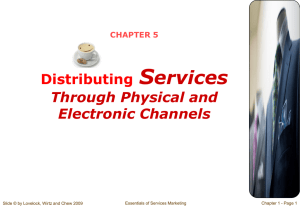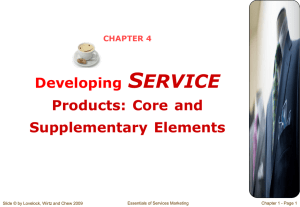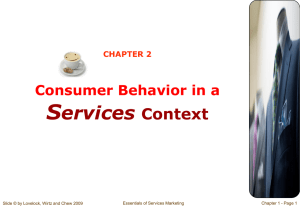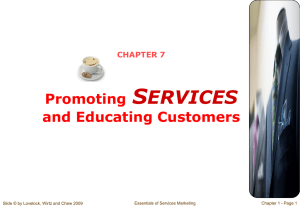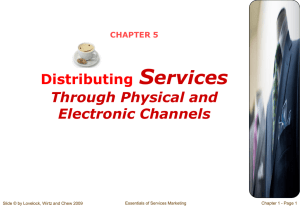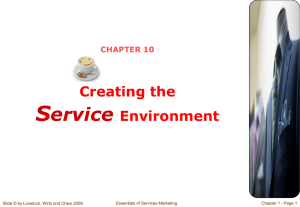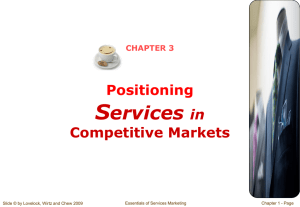Chapter 4 powerpoint file
advertisement
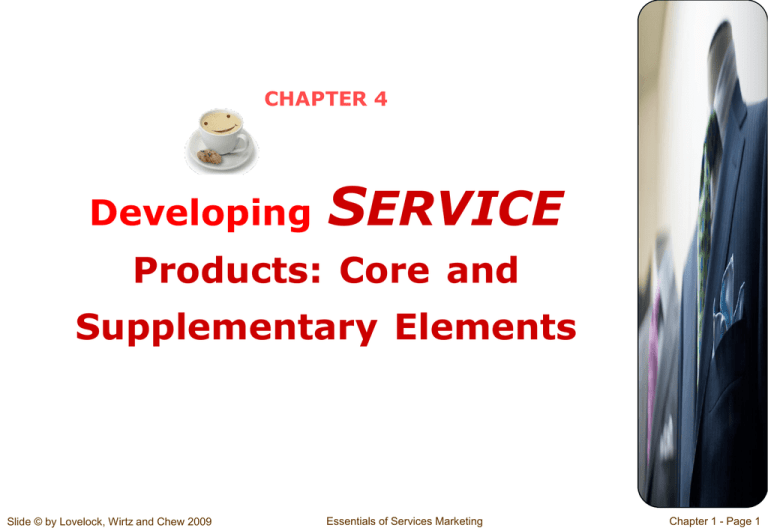
CHAPTER 4 Developing SERVICE Products: Core and Supplementary Elements Slide © by Lovelock, Wirtz and Chew 2009 Essentials of Services Marketing Chapter 1 - Page 1 Overview of Chapter 4 Designing a Service Product The Flower of Service Branding Service Products and Experiences New Service Development Slide © by Lovelock, Wirtz and Chew 2009 Essentials of Services Marketing Chapter 1 - Page 2 Service Product A service product comprises all elements of service performance, both tangible and intangible, that create value for customers. The service concept is represented by: A core product, Accompanied by supplementary services Slide © by Lovelock, Wirtz and Chew 2009 Essentials of Services Marketing Chapter 1 - Page 3 Designing a Service Concept (1) Core Product Central component that supplies the principal, problem-solving benefits customers seek Supplementary Services Augment the core product, facilitating its use and enhancing its value and appeal Delivery Processes Used to deliver both the core product and each of the supplementary services Slide © by Lovelock, Wirtz and Chew 2009 Essentials of Services Marketing Chapter 1 - Page 4 Designing a Service Concept (2) Service concept design must address the following issues: How the different service components are delivered to the customer The nature of the customer’s role in those processes How long delivery lasts The recommended level and style of service to be offered Slide © by Lovelock, Wirtz and Chew 2009 Essentials of Services Marketing Chapter 1 - Page 5 Integration of Core Product, Supplementary Elements and Delivery Process (Fig. 4.3) Slide © by Lovelock, Wirtz and Chew 2009 Essentials of Services Marketing Chapter 1 - Page 6 The Flower of Service Slide © by Lovelock, Wirtz and Chew 2009 Essentials of Services Marketing Chapter 1 - Page 7 The Flower of Service (Fig 4.4) (1) Information Payment Billing Consultation Core Exceptions Order-Taking Hospitality Safekeeping KEY: Facilitating elements Enhancing elements Slide © by Lovelock, Wirtz and Chew 2009 Essentials of Services Marketing Chapter 1 - Page 8 The Flower of Service (2) There are two kinds of supplementary services Facilitating supplementary services – either needed for service delivery, or help in the use of the core product Enhancing supplementary service – add extra value for the customer In a well-designed and well-managed service organization, the petals and core are fresh and wellformed Market positioning strategy helps to determine which supplementary services should be included Slide © by Lovelock, Wirtz and Chew 2009 Essentials of Services Marketing Chapter 1 - Page 9 Supplementary Services (1) Facilitating Information – customers often require information about how to obtain and use a product or service Order-Taking – Customers need to know what is available and may want to secure commitment to delivery. The process should be fast and smooth Billing – Bills should be clear, accurate and intelligible Payment – Customers may pay faster and more cheerfully if you make transactions simple and convenient for them Slide © by Lovelock, Wirtz and Chew 2009 Essentials of Services Marketing Chapter 1 - Page 10 Supplementary Services (2) Enhancing Consultation – Value can be added to goods and services by offering advice and consultation tailored to each customer’s needs and situation Hospitality – Customers who invest time and effort in visiting a business and using its services deserve to be treated as welcome guests Safekeeping – Customers prefer not to worry about looking after the personal possessions that they bring with them to a service site Exceptions – Customers appreciate some flexibility when they make special requests and expect responsiveness when things don’t go according to plan Slide © by Lovelock, Wirtz and Chew 2009 Essentials of Services Marketing Chapter 1 - Page 11 Facilitating Services – Examples of Information (Fig. 4.5) Slide © by Lovelock, Wirtz and Chew 2009 Essentials of Services Marketing Chapter 1 - Page 12 Facilitating Services – Examples of Order-Taking (Fig. 4.7) Slide © by Lovelock, Wirtz and Chew 2009 Essentials of Services Marketing Chapter 1 - Page 13 Facilitating Services – Examples of Billing Slide © by Lovelock, Wirtz and Chew 2009 Essentials of Services Marketing (Fig. 4.9) Chapter 1 - Page 14 Facilitating Services – Examples of Payment (Fig. 4.10) Slide © by Lovelock, Wirtz and Chew 2009 Essentials of Services Marketing Chapter 1 - Page 15 Enhancing Services – Examples of Consultation (Fig. 4.11) Slide © by Lovelock, Wirtz and Chew 2009 Essentials of Services Marketing Chapter 1 - Page 16 Enhancing Services – Examples of Hospitality (Fig. 4.13) Slide © by Lovelock, Wirtz and Chew 2009 Essentials of Services Marketing Chapter 1 - Page 17 Enhancing Services – Examples of Safekeeping (Fig. 4.14) Slide © by Lovelock, Wirtz and Chew 2009 Essentials of Services Marketing Chapter 1 - Page 18 Enhancing Services – Examples of Exceptions (Fig. 4.15) Slide © by Lovelock, Wirtz and Chew 2009 Essentials of Services Marketing Chapter 1 - Page 19 Managerial Implications Not every core product is surrounded by supplementary elements from all eight clusters Nature of product helps to determine: Which supplementary services must be offered Which might usefully be added to enhance value and ease of doing business with the organization People-processing and high contact services tend to have more supplementary services Firms that offer different levels of service often add extra supplementary services for each upgrade in service level Slide © by Lovelock, Wirtz and Chew 2009 Essentials of Services Marketing Chapter 1 - Page 20 Branding Service Products and Experiences Slide © by Lovelock, Wirtz and Chew 2009 Essentials of Services Marketing Chapter 1 - Page 21 Service Products A product implies a defined and consistent “bundle of output” Firms can differentiate its bundle of output from competitors’ Providers of more intangible services also offer a “menu” of products Represent an assembly of elements that are built around the core product May include certain value-added supplementary services Slide © by Lovelock, Wirtz and Chew 2009 Essentials of Services Marketing Chapter 1 - Page 22 Product Lines And Brands Most service organizations offer a line of products rather than just a single product. They may choose among 3 broad alternatives: Single brand to cover all products and services A separate, stand-alone brand for each offering Some combination of these two extremes Slide © by Lovelock, Wirtz and Chew 2009 Essentials of Services Marketing Chapter 1 - Page 23 Spectrum of Branding Alternatives (Fig 4.18) Source: derived from Aaker and Joachimsthaler Slide © by Lovelock, Wirtz and Chew 2009 Essentials of Services Marketing Chapter 1 - Page 24 Example: British Airways Subbrands British Airways offers seven distinct air travel products Four intercontinental offerings: - First (deluxe service) - Club World (business class) - World Traveller Plus (premier economy class) - World Traveller (economy class) Two intra-European offerings: - Club Europe (business class) - Euro-Traveller (economy class) - UK Domestic (economy class between London and major British cities Slide © by Lovelock, Wirtz and Chew 2009 Essentials of Services Marketing Chapter 1 - Page 25 Offering a Branded Experience (1) Branding can be used at both company and product levels Corporate brand: Easily recognized Holds meaning to customers Stands for a particular way of doing business Product brand: Helps firm establish mental picture of service in consumers’ minds Helps clarify value proposition Slide © by Lovelock, Wirtz and Chew 2009 Essentials of Services Marketing Chapter 1 - Page 26 Offering A Branded Experience (2) “The brand promise or value proposition is not a tag line, an icon, or a color or a graphic element, although all of these may contribute. It is, instead, the heart and soul of the brand….” Don Schultz Slide © by Lovelock, Wirtz and Chew 2009 Essentials of Services Marketing Chapter 1 - Page 27 New Service Development Slide © by Lovelock, Wirtz and Chew 2009 Essentials of Services Marketing Chapter 1 - Page 28 A Hierarchy of New Service Categories (1) 1. Style changes Visible changes in service design or scripts 2. Service improvements Modest changes in the performance of current products 3. Supplementary service innovations Addition of new or improved facilitating or enhancing elements 4. Process-line extensions Alternative delivery procedures Slide © by Lovelock, Wirtz and Chew 2009 Essentials of Services Marketing Chapter 1 - Page 29 A Hierarchy of New Service Categories (2) 5. Product-line extensions Additions to current product lines 6. Major process innovations Using new processes to deliver existing products with added benefits 7. Major service innovations New core products for previously undefined markets Slide © by Lovelock, Wirtz and Chew 2009 Essentials of Services Marketing Chapter 1 - Page 30 Achieving Success in Developing New Services In developing new services, Core product is of secondary importance Ability to maintain quality of the total service offering is key Accompanying marketing support activities are vital Market knowledge is of utmost importance Slide © by Lovelock, Wirtz and Chew 2009 Essentials of Services Marketing Chapter 1 - Page 31 Success Factors in New Service Development Market synergy Good fit between new product and firm’s image/resources Advantage vs. competition in meeting customers’ needs Strong support from firm during/after launch Firm understands customer purchase decision behavior Organizational factors Strong interfunctional cooperation and coordination Internal marketing to educate staff on new product and its competition Employees understand importance of new services to firm Market research factors Scientific studies conducted early in development process Product concept well defined before undertaking field studies Slide © by Lovelock, Wirtz and Chew 2009 Essentials of Services Marketing Chapter 1 - Page 32 Summary of Chapter 4: Developing Service Concepts (1) Creating services involve: Designing core product, supplementary services and delivery process Flower of service includes core product and two types of supplementary services: facilitating and enhancing Facilitating services include information, order taking, billing, and payment Enhancing services include consultation, hospitality, safekeeping, and exceptions Spectrum of branding alternatives exists for services Branded house Subbrands Endorsed brands House of brands Slide © by Lovelock, Wirtz and Chew 2009 Essentials of Services Marketing Chapter 1 - Page 33 Summary of Chapter 4: Developing Service Concepts (2) Seven categories of new services: Style changes Service improvements Supplementary service innovations Process-line extensions Product-line extensions Major process innovations Major service innovations Success factors in new service development: Market synergy Organizational factors Market research factors Slide © by Lovelock, Wirtz and Chew 2009 Essentials of Services Marketing Chapter 1 - Page 34
